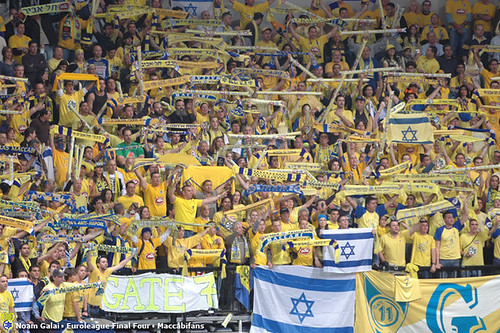 During the 2009-10 Euroleague season, one of the most watched statistics was totally off-court; with financial stress pervasive throughout The Continent, most European basketball franchises prepared for the worst and tightened belts in expectation of lower turnouts.
During the 2009-10 Euroleague season, one of the most watched statistics was totally off-court; with financial stress pervasive throughout The Continent, most European basketball franchises prepared for the worst and tightened belts in expectation of lower turnouts.
And once all was said and done, the results were … mixed. With last season’s biggest draw Alba Berlin not in the competition, the overall 2009-10 Euroleague attendance figures for regular-season/Top 16 play decreased 3.5% overall year-on-year, bringing total attendance just under the 1 million threshold achieved in 2008-09.
(For comparison’s sake, NBA regular-season attendance figures for 2009-10 were down just about 2% against 2008-09.)
While the best numbers were completely unsurprisingly turned in by Maccabi Tel Aviv and Partizan Belgrade, the level of (financial) devotion shown in some areas was quite eye-opening. Spain and Greece, two of the EU nations thought to be hit the hardest by the limp global economy, actually impressive rises in their flagship clubs’ attendance rates: FC Barcelona, Real Madrid, Baskonia, Unicaja, Olympiacos and Panathinaikos all posted gains on 2008-09. Good to know folks in these great basketball cultures have their priorities straight.
Attendance figures follow; teams are ranked in terms of straight-up attendance while ranking in average capacity is in parentheses and average capacity filled per game is expressed as a percentage at the end of a given line. Efes Pilsen and Oldenburg played some games in larger arenas, while Pionir Arena was alternately fitted to seat 6,000 or 6,700 this season. And speaking of Partizan Belgrade, that average attendance rate is no typo: All but one Euroleague game in Belgrade were played before a standing-room-only full-capacity crowd.
1. (2) Maccabi Tel Aviv: 11,000/11,000 – 100%
2. (19) Panathinaikos: 10,508/19,000 – 55.3%
3. (15) Real Madrid: 9,954/13,780 – 72.2%
4. (3) Caja Laboral Baskonia: 9,313/9,635 – 96.7%
5. (6) Unicaja: 8,941/10,000 – 89.4%
6. (13) Lietuvos Rytas: 8,370/11,000 – 76.1%
7. (17) Olympiacos: 7,214/11,039 – 65.3%
8. (12) Efes Pilsen: 6,875/3,500 or 11,356 – 79.2%
9. (7) Regal FC Barcelona: 6,719/7,711 – 87.1%
10. (1) Partizan Belgrade: 6,300/6,000 or 6,700 – 100.6%
11. (4) Asvel Basket: 5,395/5,601 – 96.3%
12. (5) Zalgiris Kaunas: 4,777/5,000 – 94.5%
13. (9) Union Olimpija: 4,406/5,300 – 83.1%
14. (8) KK Cibona Zagreb: 4,368/5,200 – 84%
15. (10) Montepaschi Siena: 4,079/5,070 – 80.5%
16. (21) Lottomatica Roma: 4,143/10,074 – 41.1%
17. (11) Entente Orleanaise: 4,018/5,070 – 79.3%
18. (14) CSKA Moscow: 3,748/5,043 – 74.3%
19. (16) BC Khimki Moscow region: 3,610/5,020 – 71.9%
20. (24) Maroussi BC: 3,198/19,000 – 16.8%
21. (20) EWE Baskets Oldenburg: 3,170/5,028 or 8,800 – 44.5%
22. (18) Asseco Prokom: 3,154/5,000 – 63.1%
23. (22) AJ Milano: 2,640/11,210 – 23.2%
24. (23) Fenerbahce Ulker: 2,420/11,356 – 21.3%

Typical scene from Belgrade
Incredibly enough, three teams – BC Khimki, Montepaschi Siena and Unicaja – saw significant *drops* in attendance for Top 16 games. In contrast, Maroussi BC might have saved any budget for 2010-11 it had, as the club’s woeful regular-season attendance of 2,218 was more than doubled to 4,833 per game in three Top 16 home matches. Maroussi set the mark for low draw of 2009-10 when just 585 watched them defeat Union Olimpija in week seven.
As for performance against last season, the majority of returning clubs – 11 of 18 – showed an upswing in gate from 2009-10. Having a particularly impressive season in terms of draw, Efes Pilsen increased its receipts by nearly 50% year-on-year: Clearly these guys should be playing more often in the 11,356-seat Abdi Ipekçi Sports Hall. Oddly enough, fellow Turkey-based squad Fenerbahçe Ülker shed an incredible 44.2% in Euroleague attendance year-on-year to occupy the bottom spot on this table.
Barça was rewarded for its superstar roster and excellent Euroleague play with a big 29.8% increase in attendance, while rivals Real Madrid managed an 18% jump. While Maccabi was able to improve on its amazing 2008-09 rate by selling every seat to every game, Partizan’s growth number was a bit deceiving.

Guess where...
Though on paper, the Undertakers saw a more than 25% decrease in attendees, this may be attributed solely to a single game played at 22,000-seat Belgrade Arena in 2009, which seriously inflated last year’s numbers; subtracting this game, Partizan saw only a 6.1% drop off the record-setting season of 2008-09. Certainly those crowds of 20,000-plus and 21,000-plus for the playoff games against Maccabi made up for it in the Black-and-White coffers.
Efes Pilsen Istanbul +49.5%
Regal FC Barcelona +29.8%
Real Madrid, +18%
Lottomatica Roma, +9.4%
Olympiacos, +7.3%
Unicaja Malaga, +5.4%
Caja Laboral Baskonia, +3.6%
Asseco Prokom, +3.04%
Panathinaikos +2.9%
Maccabi Electra Tel Aviv, +1.57%
Union Olimpija, +1.5%
CSKA Moscow, -2.1%
Žalgiris Kaunas, -2.15%
Cibona Zagreb, -12.3%
Armani Jeans Milano, -13.5%
Montepaschi Siena -13.75%
Partizan Belgrade, -26.9% (-6.1%)
Fenerbahçe Ülker, -44.2%
BallinEurope will now attempt to seek out attendance figures from across Europe for 2009-10; they’ll be presented as they come in.



